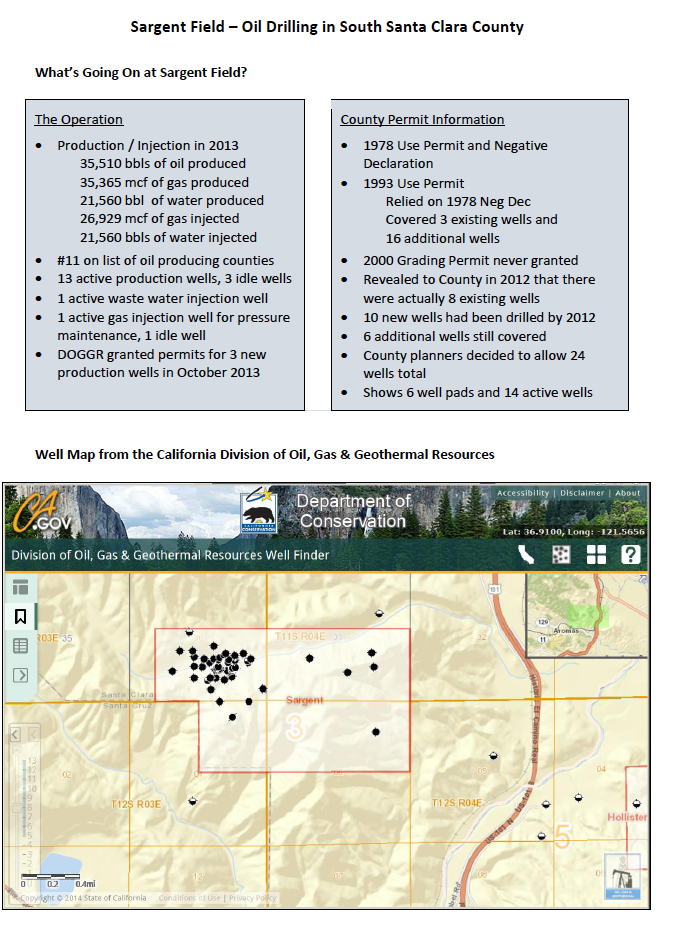Congratulations, Monterey County!
Congratulations to all the hard-working activists, including members of our own chapter, who made the passage of Measure Z a reality! Monterey is now the seventh California county to ban fracking and the first major oil-producing county to do so! A great win for clean water! Way to go!
It’s not too late to show your support for our neighbor's efforts. They still need donations to help retire their campaign debt. Send a cheerful note with your check to Protect Monterey County, P.O. Box 1946, Monterey, CA 93942. Be part of the winning team!
Who We Are
Members of the Loma Prieta Chapter formed the Fracking Action Committee (FAC) in the summer of 2013 upon learning about the hazards of fracking and our region’s role in oil and gas production. Since then other local environmental groups have joined our efforts working to create a clean energy future for local residents.
Our Goal
To keep local air and water cleaner by preventing expansion of oil and gas drilling operations.
Projects
In Santa Clara County we are currently focused on persuading the Board of Supervisors to update the General Plan, to prohibit additional county permits for oil and gas exploration. As nearby counties take action on this issue, we get involved in ways that support them in their efforts. We’re also researching oil wells in San Mateo County and staying abreast of statewide legislation.
Contact Info
Committee Chair: Mike Kerhin
mikekerhin@gmail.com, 510/858-1095
Aspects of our Committee:
Fracking Action in Santa Clara County
Fracking Action Efforts in Santa Clara County
FAC and a growing grassroots coalition – including 350SiliconValley.org, Peninsula Democratic Coalition, Food and Water Watch, and the Center for Biological Diversity - have brought our concerns to the Santa Clara County officials. Between May 2014 and March 2016, we met with all the county supervisors and/or their staff as well as the County’s Planning Office. An item to promote clean energy and control production of fossil fuels was placed on the County’s Public Safety and Justice Committee’sagenda for February 2015. The Committee heard comments and referred the item to the County’s Housing, Land Use, Environment and Transportation Committee (HLUET)to report on fracking and fracking regulation in Santa Clara County.
The HLUET item was rescheduled from July to September, and then the hearing was cancelled by staff due to improper referral from the Public Safety and Justice Committee. Nonetheless, staff made a report that partially claimed lack of staff resources to work on this issue, and the public was allowed to comment. We sent a letter continuing to advocate for a relatively simple alternative, a one-paragraph General Plan Amendment.
Going Forward
Talks are continuing with the Board of Supervisors, and we’re hoping success is on the near horizon.
We are also researching oil drilling sites in San Mateo County and plan to share our results with appropriate public officials.
Oil and Gas in Santa Clara County
According to data from California Department of Oil, Gas and Geothermal Resources (DOGGR), Sargent Oil Field is the only operating oil field in Santa Clara County. It’s located at the southern edge of the county, bordered by the Pajaro River and the Highway 101 and 129 interchange. Sargent Ranch covers an area that’s almost two square miles, and Sargent Field drills on about 320 acres of the ranch. The area is very close to the borders of San Benito, Santa Cruz and Monterey Counties.
There are currently 16 active (or potentially active) oil and gas wells, 2 injection wells, and 40 plugged or abandoned wells. Currently the wells are leased to and operated by Patriot Resources, LLC, headquartered in Colorado. Future investors may decide to maximize the return from this property’s oil and gas resources by using the latest enhanced recovery techniques (e.g., cyclic steam injection, fracking, horizontal drilling) to extract the remaining oil and gas from old wells. These techniques are even more damaging to the environment than older techniques. County Use Permits for Sargent Oil Field have been declared exempt from CEQA, and no EIR has been done. As is, there are a number of risks associated with this oil field:
- Toxic chemicals are used in all drilling operations, not just hydraulic fracturing, and these toxic chemicals are often released into the neighboring air, water and soil.
- Drilling brings up additional chemicals trapped in the earth’s surface such as arsenic and brine. Heavy metals are then added to the toxic chemicals already in the “produced water” from wells.
- Drilling releases methane into aquifers and the atmosphere. Methane is a more potent greenhouse gas than CO2.
- Surface water and groundwater can be contaminated as a result of oil drilling. Three creeks flow through the Sargent Oil Field – Tar Spring Creek, Pescadero Creek and Sargent Creek. These creeks are part of the Pajaro River watershed. Contamination by Sargent Oil operations could affect residents and farmers in the Pajaro River basin.
- Hazardous spills can occur during transport of chemicals and produced oil and gas.
- Wastewater must be disposed of, and often the solution is to inject it back underground using a wastewater disposal or injection well (one such well exists at Sargent Field). Failures in these wells can contaminate aquifers. A polluted and poisoned aquifer will not repair itself.
- Injection wells can also increase the risk of earthquakes. The Sargent Oil Field is located in one of the most seismically active areas of North America. The San Andreas Fault is about 2 miles away from some of the active wells.
- California is suffering through a drought of epic proportions. Large amounts of water are used for all methods of oil drilling. We cannot afford to waste this precious resource. We don’t know where Patriot Resources get its water for their drilling operations.
What's going on at Sargent Field?
What's going on at Sargent Field?

Neighboring Counties
Local communities frustrated by the inaction by Governor Brown and other leaders in Sacramento are looking to local officials to ban fracking or are taking the issue directly to voters.
Monterey County
In the spring of 2016, a coalition of citizens calling themselves Protect Monterey County gathered enough signatures to get an anti-fracking initiative on the November 2016 ballot. Members of our committee have canvassed neighborhoods, made donations, and encouraged members to volunteer. The campaign organizers welcome help up to the November 8 election. Go to http://www.protectmontereycounty.org/ for more info.
Alameda County
On July 19, 2016, Alameda County Board of Supervisors voted 5-0 to pass an ordinance that bans fracking and other high intensity oil recovery practicesin the county. The hard fought victory for environmentalists makes Alameda County the 5th county in the state to ban fracking and the first in the San Francisco Bay Area.
Santa Cruz County
In 2013 Santa Cruz County Supervisors approved a moratorium on oil and gas exploration and development within the county until the risks to public health could be examined further. To date, the moratorium is still in place.
San Benito County
Even though the oil industry outspent a grassroots coalition 14 to 1, voters in San Benito County approved Measure J, a ban on fracking as well as cyclic steam injection and acidization. We supported them by organizing a fun and educational Global Frackdown in Hollister.

Contact Information
Committee Chair: Mike Kerhin
mikekerhin@gmail.com, 510/858-1095
Where to Get More Information
(list compiled by Mary Hsia-Coron)
Additional information about the risks of injection wells, and about the geology and hydrology of the area surrounding Sargent Oil Field can be found in these online resources:
1) Geology and Ground Water of the Pajaro Valley Area, Santa Cruz and Monterey, California, by K. S. Muir, U.S. Geological Survey, 1972 – http://pubs.usgs.gov/of/1973/0199/report.pdf
2) Geology of the San Juan Bautista Quadrangle, by John Eliot Allen, State of Calif. Division of Mines, 1946 – https://archive.org/stream/geologyofsanjuan00allerich#page/n3/mode/2up
3) Injection Wells – The Poison Beneath Us, by Abrahm Lustgarten, article in ProPublica, June 21, 2012 – http://www.propublica.org/article/injection-wells-the-poison-beneath-us
4) Injection Wells Spawn Powerful Earthquake, by David Biello, article in Scientific American, July 12, 2013 – http://www.scientificamerican.com/article.cfm?id=drilling-and-pumping-wells-spawn-powerful-earthquakes
5) Pajaro Watershed Flood Protection Plan, by CSU Monterey Bay Students in Robert Curry’s Class, 2003 – http://www.pajarowatershed.org/archive/uploads/Flood%20Protection/Watershed%20Studies/Curry%20Flood%20Protection%20Plan%202003.pdf
6) Geohydrology of Recharge and Seawater Intrusion in the Pajaro Valley, Santa Cruz and Monterey Counties, California, by US Geological Survey, by Randall T. Hanson, 2003 – http://pubs.usgs.gov/fs/fs-044-03/pdf/fs-044-03.pdf